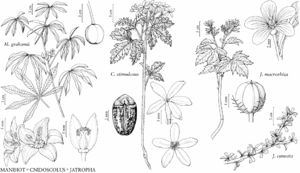Jatropha cuneata
Contr. Dudley Herb. 3: 272, plate 62, fig. 1. 1943.
Shrubs, to 2 m, dioecious. Stems spreading, yellow to yellow-brown [gray], much-branched, woody-succulent, glabrous; short shoots common; latex watery, yellow in young shoots, red in older shoots. Leaves deciduous, usually fascicled on short shoots; stipules absent; petiole 0(–0.2) cm, not stipitate-glandular; blade obovate-spatulate, 0.7–1.9 × 0.3–0.9 cm, unlobed (shallowly 3-lobed on active shoots), base attenuate, margins entire, apex usually rounded, sometimes emarginate, coriaceous, surfaces glabrous; venation pinnate (palmate if lobed). Inflorescences on short shoots, cymes or flowers solitary; peduncle 0.4–0.6 cm; bracts 0.4–1 mm, margins entire, glabrous. Pedicels 1–4(–6.5) mm. Staminate flowers: sepals connate basally, ovate-lanceolate, 2.5–4 × 0.6–1 mm, margins entire, apex acute, surfaces glabrous; corolla white, tubular-urceolate, petals connate most of length, 4–6 × 1.3–2 mm, surfaces glabrous; stamens 10 in 2 whorls (5 + 5); filaments of both whorls connate almost to top, outer whorl 1–2.5 mm, inner series 2.5–4 mm. Pistillate flowers resembling staminate, but sepals distinct, 1.5–3 × 0.5–1 mm; petals 4–4.5 × 1–1.5 mm; carpel 1; styles 0.5–1 mm. Capsules spheric, 0.9–1.1 × 0.9–1.1 cm, tardily dehiscent. Seeds solid dark to golden brown, spheric, 10 × 10 mm; caruncle absent. 2n = 44 (Mexico).
Phenology: Flowering and fruiting late spring–summer.
Habitat: Dry rocky limestone mesas, sandy areas, bajadas.
Elevation: 0–800 m.
Distribution
Ariz., Mexico (Baja California, Baja California Sur, Sonora).
Discussion
In Arizona, Jatropha cuneata is found only in Pima County, primarily in Organ Pipe Cactus National Monument and Cabeza Prieta National Wildlife Refuge. Its stems have been used in basket making.
Selected References
None.
